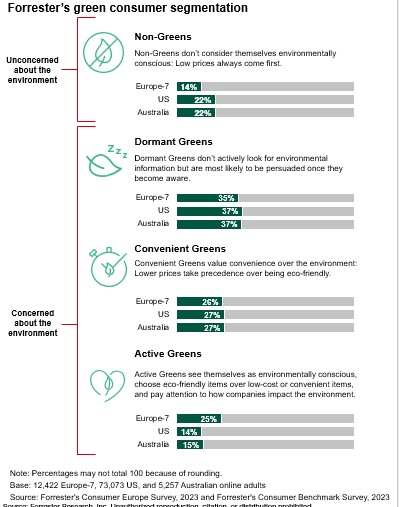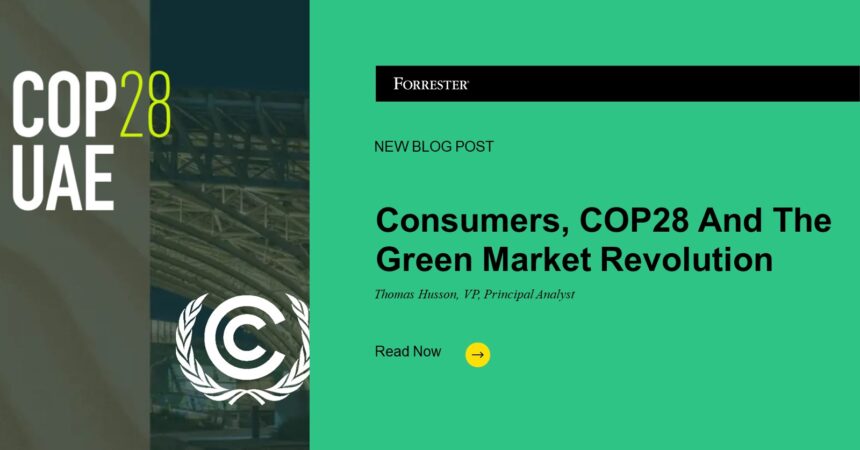With UN Climate Change Conference COP28 starting today in Dubai, increased media and activist attention on the implications of climate change is shaping consumers’ perceptions of and attitudes toward environmental sustainability.
The current global economic and geopolitical context is likely to prevent a breakthrough political consensus to drastically accelerate the transition towards a low-carbon economy and reduce our dependency on fossil fuels. Even if no breakthrough political consensus emerges in Dubai for COP28, businesses must better understand their customers’ attitudes toward environmental sustainability because:
- Consumers will have to change their behaviors — either by choice or by force. As routines are disrupted and governments change laws to protect their lands and citizens — not to mention increasing visibility to consumers of climate disasters, skyrocketing prices for fossil fuel energy sources, and the exploitation of natural resources in manufacturing — there’s no doubt that many behaviors will change.
- Firms can no longer ignore the green market revolution. Massive government spending with the Inflation Reduction Act (IRA) in the US, huge investments in renewable energies in China, acceleration in green technology innovation, tougher regulation especially in Europe including CSRD (Corporate Sustainability Reporting Directive) and CBAM (Carbon Border Adjustment Mechanism) will all impact global trade and companies’ investment decisions and disrupt existing markets. Forrester expects the “green economy” to grow significantly around the world. All told, we forecast that the global cumulative spend on how we make products from 2023 until 2050 to be $67 trillion. Some 40% of the spend will flow to circular models of product creation and reuse in fashion, consumer electronics, and automobiles.
The reality is that there is no single green or sustainable consumer. Values and attitudes vary greatly within the same age group or across different countries. It is critical to base your strategy on nuanced facts and to segment your customer base into distinct groups.
Together with my colleague Sucharita Kodali, we have just updated Forrester’s Green segmentation leveraging data from Forrester’s Consumer Benchmark Survey, 2023. We have mapped online adults in Australia, the US, and the Europe-5 markets to four segments that display various levels of affinity for environmental sustainability. Forrester grouped consumers into four segments according to their answers to three questions:
- Do they regularly seek out information before buying green products and to understand what they can do to be green?
- Do they actually purchase green products even when it is less convenient to do so?
- Do they see the environment as a secondary factor after price or convenience in their purchasing decision process?
The result? Consumers are evolving into four distinct groups as they realize that their consumption habits affect both the environment and their daily lives (see figure below):

- Active Greens are environmentally conscious consumers. These consumers actively pay attention to companies’ impact on the environment, are concerned about the impact of climate change on society, and overwhelmingly choose eco-friendly items over low-cost or convenient items. They regularly purchase natural and organic products and are disappointed if product packaging isn’t recyclable or compostable. They feel hopeful, moral, and confident when they act in an environmentally responsible way.
- Convenient Greens value convenience over the environment. Among US Convenient Greens, 78% would like to understand more about how their purchases impact the environment, but 56% say reducing their environmental impact is too much work. They want to do what’s best for the planet, but convenience and cost are most important.
- For Dormant Greens, the environment isn’t an important purchase criterion. They tend to most value price and convenience in their purchases, That said, about one-quarter of Dormant Greens in Europe-5 markets (26%) and the US (22%) would like to understand more about how their purchases impact the environment.
- Non-Greens don’t consider themselves environmentally conscious. They primarily focus on cost and are least concerned about the impact of climate change on society. Only very few Non-Greens in the US (7%) and Europe-5 markets (9%) would like to know how their purchase impacts the environment.
Firms investing now to take part in the green market revolution will gain a competitive advantage.
Firms should launch new offerings for the minority of consumers who can afford to pay a premium for greener products. However, don’t overlook the frustration and cognitive dissonance among Dormant and Convenient Green consumers: now is the time to innovate to deliver more environmental value for the same price.
Until now, most companies have viewed environmental sustainability as primarily an ethical responsibility with added benefits to brand and modest cost savings. Moving forward it will become a financial and regulatory obligation they can’t ignore, and much more importantly, an unprecedented business opportunity. Most firms haven’t really started their transformation to anticipate the green market revolution. Those that invest now will gain competitive advantage. This requires bold leadership to evolve business models, cross-functional execution to align the organization, and trust to engage multiple stakeholders.
Clients who want to better understand consumers’ green behaviors and attitudes can read the latest “Forrester’s Green Consumer Segmentation, 2024” report and schedule a conversation with my colleague Sucharita Kodali or with me to go into the details of what it means for them.








